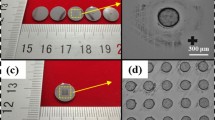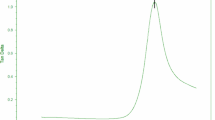Abstract
In this work we demonstrate the hot-embossing process under different forming conditions such as forming temperature, load, and holding time in pressing, in order to determine the suitable conditions required for linear patterning on polymer plates (PMMA and PC). Results showed that the replicated pattern depth increased in proportion to an increase in the forming temperature, load, and time. The reduction of the workpiece thickness increased according to the holding time in the pressing process. In the process of time, the reduction ratio of the workpiece thickness decreased due to the surface area increment of the workpiece, while the pressure on the workpiece declined. In order to reduce the bulging ratio we introduced a temperature difference between the upper and the lower punch.
Similar content being viewed by others
References
Hardt, D., Ganesan, B., Qi, W., Dirckx, M. and Rzepniewski, A., “Process Control in Micro-Embossing: A Review,” Innovation in Manufacturing Systems and Technology, 2004.
Choi, C. G., “Fabrication of optical waveguides in thermosetting polymers using hot embossing,” J. Micromechanics and Microengineering, Vol. 14, No. 7, pp. 945–949, 2004.
Kim, W. S., Yoon, K. B. and Bae, B. S., “Nanopatterning of photonic crystals with a photocurable silica-titania organicinorganic hybrid material by a UV-based nanoimprint technique,” J. Mater. Chem., Vol. 15, No. 42, pp. 4535–4539, 2005.
Ishihara, K., Fujita, M., Matusubara, I., Asano, T. and Noda, S., “Direct Fabrication of Photonic Crystal on Glass Substrate by Nanoimprint Lithography,” Japanese Journal of Applied Physics, Vol. 45, No. 7, pp. 210–212, 2006.
Kim, H.-J. and Kim, D.-E., “Nano-scale Friction: A Review,” Int. J. Prec. Eng. Manuf., Vol. 10, No. 2, pp. 141–151, 2009.
Heidari, B., Maximov, I. and Montelius, L., “Nanoimprint lithography at the 6 in. wafer scale,” J. Vac. Sci. Technol. B, Vol. 18, No. 6, pp. 3557–3560, 2000.
Cameron, N. S., Roberge, H., Veres, T., Jakeway, S. C. and Crabtree, H. J., “High fidelity, high yield production of microfluidic devices by hot embossing lithography: rheology and stiction,” Lab Chip, Vol. 6, No. 7, pp. 936–941, 2006.
Chang, W.-S., Choi, M.-J., Kim, J.-G., Cho, S.-H. and Whang, K.-H., “Thin Film Micromachining Using Femtosecond Laser Photo Patterning of Organic Self-assembled Monolayers,” Int. J. Prec. Eng. Manuf., Vol. 7, No. 1, pp. 13–17, 2006.
Guo, L. J., “Recent Progress in nanoimprint technology and its application,” J. Phys. D: Applied Physics, Vol. 37, No. 11, pp. 123–141, 2004.
Scheer, H. C. and Schulz, H., “A contribution to the flow behaviour of thin polymer films during hot embossing lithography,” Microelectronic Eng., Vol. 56, No. 3-4, pp. 311–332, 2001.
Yao, D. and Virupaksha, V. L., “Study on Squeezing Flow During Nonisothermal Embossing of Polymer Microstructures,” Polymer eng. and Sci., Vol. 45, No. 5, pp. 652–660, 2005.
Author information
Authors and Affiliations
Corresponding author
Rights and permissions
About this article
Cite this article
Lee, CS., Kang, CG. & Youn, SW. Effect of forming conditions on linear patterning of polymer materials by hot embossing process. Int. J. Precis. Eng. Manuf. 11, 119–127 (2010). https://doi.org/10.1007/s12541-010-0015-2
Received:
Accepted:
Published:
Issue Date:
DOI: https://doi.org/10.1007/s12541-010-0015-2




